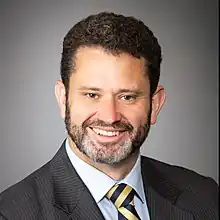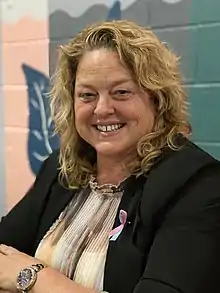| State Government | |
 The South Australian Government logo used to corporately identify the executive government and its agencies (left); and the Coat of arms of South Australia, used across the government (right) | |
| Formation |
|
|---|---|
| Founding document | Constitution of South Australia |
| State | |
| Country | |
| Website | sa |
| Crown | |
| Head of state (sovereign) | Monarch (King) |
| Vice-regal representative | Governor |
| Seat | Government House |
| Legislative branch | |
| Legislature | Parliament of South Australia |
| Meeting place | Parliament House |
| Executive branch | |
| Head of government | Premier |
| Main body | Cabinet of South Australia |
| Appointed by | Governor on behalf of the King of Australia in right of the State of South Australia. |
| Headquarters | State Administration Centre 200 Victoria Square |
| Main organ | Executive Council of South Australia |
| Departments | 15 departments |
| Judicial branch | |
| Court | Supreme Court |
| Seat | Supreme Court building, Adelaide |
The Government of South Australia, also referred to as the South Australian Government, SA Government or more formally, His Majesty’s Government, is the Australian state democratic administrative authority of South Australia. It is modelled on the Westminster system of government, which is governed by an elected parliament.
History
Until 1857, the Province of South Australia was ruled by a Governor responsible to the British Crown.[1] The Governor in Council, responsible to the British Government, made the laws.[2]
The Government of South Australia was formed in 1857,[1] as prescribed in its Constitution created by the Constitution Act 1856 (an act of parliament of the then United Kingdom of Great Britain and Ireland under Queen Victoria), which created South Australia as a self-governing colony rather than being a province governed from Britain.[3] An elected Parliament, responsible to the electors, became the legislature.[2]
The Executive comprised ministers selected from the Parliament. The Governor was no longer able to make decisions or appoint people to government, and the new Parliament and Executive took over almost all of the powers held by the Secretary of State for the Colonies regarding the appointment to official positions in the colony, immigration, and customs matters.[2]
Since the federation of Australia in 1901, South Australia has been a state of the Commonwealth of Australia, which is a constitutional monarchy, and the Constitution of Australia regulates the state of South Australia's relationship with the Commonwealth.[4] Under the Australian Constitution, South Australia ceded legislative and judicial supremacy to the Commonwealth, but retained powers in all matters not in conflict with the Commonwealth.[5][6]
In 1934, the 1856 Act was repealed, along with a few other acts which had amended it, and replaced by the Constitution Act 1934,[7] which is still in force, with amendments.[8]
Legislative powers
Legislative power rests with the Parliament of South Australia, which consists of the House of Assembly and the Legislative Council, with general elections held every four years.[9] At these fixed four-yearly elections the whole Assembly is up for re-election, as is half of the Council is; the only exception is after a double dissolution held in accordance with Section 41 of the state Constitution, after which the whole Assembly and Council are up for re-election. Unlike the federal double dissolution procedure, the SA double dissolution procedure can only be used if the same bill, or much the same bill, has been twice rejected by the Council, after being introduced by the Assembly, with the two rejections separated by a general election.[10]
Executive and judicial powers
South Australia is governed according to the principles of the Westminster system, a form of parliamentary government based on the model of the United Kingdom.[11]
Executive power rests formally with the Executive Council, which consists of the governor and senior ministers.[11] The Governor plays an important practical role under the state's constitution and fulfils a symbolic role as local head of state. The Governor is appointed by the King and, for most practical purposes, exercises His Majesty's powers in the state. These include the fundamental powers to dissolve Parliament, call elections and appoint and dismiss ministers. The Governor in Executive Council is the formal mechanism for administration of the state. Many of the decisions made by Cabinet do not have legal effect until they are signed by the Governor in Executive Council. All items for the approval of the Governor in Executive Council must first be considered by Cabinet, with the exception of the assent to Acts. When exercising a statutory power, the Governor must act with the advice and consent of Executive Council. All ministers are ex officio members of Executive Council.[12]
In practice, executive power is exercised by the premier of South Australia and the Cabinet of South Australia, who advise the Governor. The Cabinet comprises 15 ministers, headed by the Premier, who are either members of the House of Assembly or the Legislative Council. Cabinet is responsible for determining policies which are submitted to Parliament.[11]
Judicial power is exercised by the Supreme Court of South Australia[13] and a system of subordinate courts,[14] but the High Court of Australia and other federal courts have overriding jurisdiction on matters which fall under the ambit of the Australian Constitution.[15]
Current ministry
As of 24 March 2022, the ministry of the South Australian Government comprised the following 14 Labor Party members and 1 Independent member:[16]
| Minister | Portfolio | Party affiliation | Shadow Minister | Portfolio | Party affiliation | ||||
|---|---|---|---|---|---|---|---|---|---|
| Peter Malinauskas MP | .png.webp) |
Labor | David Speirs MP | .jpg.webp) |
|
Liberal | |||
| Susan Close MP |  |
|
Labor | John Gardner MP |  |
|
Liberal | ||
| Kyam Maher MLC |  |
|
Labor | Josh Teague MP |
|
Liberal | |||
| Tom Koutsantonis MP |  |
|
Labor | Liberal | |||||
| Stephen Mullighan MP |  |
Labor |
|
Liberal | |||||
| Zoe Bettison MP |  |
|
Labor | Liberal | |||||
| Chris Picton MP |  |
|
Labor | Liberal | |||||
| Katrine Hildyard MP |  |
|
Labor | Liberal | |||||
| Nat Cook MP |  |
|
Labor | Liberal | |||||
| Clare Scriven MLC |  |
|
Labor | Liberal | |||||
| Blair Boyer MP |  |
|
Labor | Liberal | |||||
| Geoff Brock MP |  |
|
Independent | Liberal | |||||
| Andrea Michaels MP |  |
|
Labor | Liberal | |||||
| Joe Szakacs MP |  |
|
Labor | Liberal | |||||
| Nick Champion MP | .jpg.webp) |
|
Labor | Liberal | |||||
Government agencies
The South Australian Government delivers services, determines policy and regulations, including legal interpretation, by a number of agencies grouped under areas of portfolio responsibility. Each portfolio is led by a government minister who is a member of the Parliament. As of March 2020 there were 28 government departments and agencies listed on sa.gov.au, being:[17]
- Attorney-General's Department (includes Forensic Science SA)[18]
- Auditor-General's Department
- Department for Child Protection (formerly Families SA, Family and Youth Services, Family and Community Services)
- Department for Correctional Services
- Country Fire Service (CFS)
- Courts Administration Authority (CAA)
- Defence SA
- Department for Education
- Electoral Commission of South Australia
- Department for Environment and Water
- Environment Protection Authority (EPA) – "independent statutory authority within the Environment and Water Portfolio"[19]
- Department for Energy and Mining[20]
- Green Industries SA[19][21]
- Department for Health and Wellbeing
- SA Housing Authority
- Department of Human Services
- Department for Innovation and Skills[22]
- South Australian Metropolitan Fire Service (MFS)
- Department for Infrastructure and Transport
- Department of the Premier and Cabinet
- Primary Industries and Regions SA (PIRSA), formerly Department of PIRSA
- Department for Trade and Investment
- Department of Treasury and Finance
- SAFECOM
- South Australia Police
- State Emergency Service
- TAFE SA
- South Australian Tourism Commission
A range of other agencies support the functions of these departments.
- The Legal Services Commission is a statutory authority, independent of government, "funded by both the South Australian and the Commonwealth Governments to provide legal assistance to South Australians".[23]
Brands
- As of 2017 SA Health is "the brand name for the health portfolio of services and agencies responsible to our Minister, the Minister for Health and Wellbeing", including:[24]
- Department for Health and Wellbeing
- SA Ambulance Service
- Commission on Excellence and Innovation in Health
- Wellbeing SA
- Various regional health networks
Government business enterprises
- South Australian Forestry Corporation trading as ForestrySA[25]
- South Australian Water Corporation trading as SA Water[26]
See also
References
- 1 2 "History". Parliament of South Australia. Retrieved 9 March 2022.
- 1 2 3 "South Australia Achieves Self Government in 1857". parliament.sa.gov.au. Retrieved 17 December 2023.
- ↑ "Constitution Act (No 2 of 19 Vic, 1855-6)". 4 January 1856. Retrieved 9 March 2022 – via Austlii.
- ↑ "Australian system of government". Parliamentary Education Office. Australian Government. 8 November 2021. Retrieved 9 March 2022.
- ↑ "Three levels of government: governing Australia". Parliamentary Education Office. 19 January 2022. Retrieved 9 March 2022.
- ↑ "The roles and responsibilities of the three levels of government". Parliamentary Education Office. 29 June 2021. Retrieved 9 March 2022.
- ↑ "Constitution Act 1934 - Notes". Retrieved 9 March 2022 – via Austlii.
- ↑ "Constitution Act 1934". Government of South Australia. Retrieved 9 March 2022 – via Austlii.
- ↑ Constitution Act 1934 (SA) s.4
- ↑ "Constitution Act 1934 - SECT 41". Retrieved 5 December 2019 – via Austlii.
- 1 2 3 "The Government of South Australia". Parliament of South Australia. Retrieved 9 March 2022.
- ↑ "Executive Council". Department of the Premier and Cabinet (SA). Retrieved 17 December 2023.
 Text has been copied from this source, which is available under a Attribution 4.0 International (CC BY 4.0) licence.
Text has been copied from this source, which is available under a Attribution 4.0 International (CC BY 4.0) licence. - ↑ "Supreme Court (SA)". Legal Services Commission of South Australia. Retrieved 9 March 2022.
- ↑ "Supreme Court". CAA. 3 November 2021. Retrieved 9 March 2022.
- ↑ "Role of the High Court". High Court of Australia. Retrieved 9 March 2022.
- ↑ "Governor's Instruments (19)" (PDF). South Australian Government Gazette. Government of South Australia. 24 March 2022. p. 894-895. Retrieved 24 March 2022.
- ↑ "Government". SA.GOV.AU. 28 January 2020. Retrieved 25 March 2020.
- ↑ "Home". Government of South Australia. Attorney General's Department. 25 March 2020. Retrieved 25 March 2020.
- 1 2 "Organisation". Environment Protection Authority. Retrieved 25 March 2020. Note link to document behind "Environment and Water Portfolio", showing an organisational structure chart: Environment & Conservation Portfolio as at 22 April 2018. Green Industries SA, EPA and DEW all report to the Minister.
- ↑ "Home". Department for Energy and Mining. 24 March 2020. Retrieved 25 March 2020.
- ↑ "About Green Industries SA". Green Industries SA. Retrieved 25 March 2020.
- ↑ "Home". South Australia. Department for Innovation and Skills. Retrieved 25 March 2020.
- ↑ "About". Legal Services Commission of SA. 25 March 2020. Retrieved 25 March 2020.
- ↑ "About SA Health". SA Health. 30 May 2017. Retrieved 26 March 2020.
- ↑ "ForestrySA Corporate Overview". ForestrySA. Archived from the original on 24 September 2015. Retrieved 18 August 2015.
- ↑ "About us". SA Water. Retrieved 18 August 2015.
